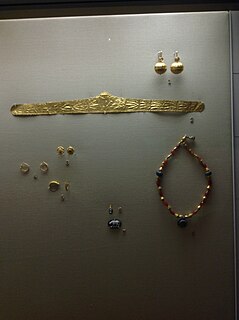Related Research Articles
Pteria was the capital of the Assyrians in northern Cappadocia. They were said by Herodotus to have been taken and ruined by Croesus in 547 BCE. It also was the place of an undecided battle between Cyrus the Great and Croesus.
Antiochia ad Pyramum was an ancient coastal city of Cilicia, on the Pyramus river, in Anatolia. It was the successor settlement to Magarsa. The location of the city is on the Karataş Peninsula, Adana Province, Turkey, a few km from the city of Karataş. The course of the Pyramus has changed markedly since ancient times and the location of the ruins is no longer adjacent to the river, but decidedly west of its present course. The formerly important ancient site of Mallus lies a few km inland from Antiochia ad Pyranum along the former course of the Pyramus.

Miletopolis or Miletoupolis (Μιλητούπολις) was a town in the north of ancient Mysia, at the confluence of the rivers Macestus and Rhyndacus, and on the west of the lake which derives its name from the town. It was a Milesian colony. Strabo mentions that a part of the inhabitants of the town were transferred to Gargara at some indeterminant time.
Ergasteria was an inland town of ancient Mysia on the road from Pergamum to Cyzicus, 440 stadia from Pergamum. It was noted by Galen as near a source of a metallic substance he called molybdaena. It was also known for silver mining in antiquity.
Eulepa (Εύλεπα) was an ancient Greek town in Cappadocia, inhabited in Hellenistic, Roman and Byzantine times.
Astyra, also known as Astyrum or Astyron (Ἄστυρον), and perhaps also Andeira (Ἀνδειρα), was a small town of ancient Aeolis and of Mysia, in the Plain of Thebe, between Antandrus and Adramyttium. It had a temple of Artemis, of which the Antandrii had the superintendence. Artemis had hence the name of Astyrene or Astirene. There was a lake Sapra near Astyra, which communicated with the sea. Pausanias, from his own observations, describes a spring of black water at Astyra; the water was hot. But he places Astyra in the territory of Atarneus. There was, then, either a place in Atarneus called Astyra, with warm springs, or Pausanias has made some mistake; for there is no doubt about the position of the Astyra of Strabo and Pomponius Mela. Astyra was a deserted place, according to Pliny's authorities; he calls it Astyre. There are said to be coins of Astyra.
Astyria, also Astyra (Ἀστυρα), was a coastal town of ancient Aeolis on the north shore of the Gulf of Adramyttium.
Hadriania or Hadrianeia was a town of ancient Mysia. It was the seat of a bishop from an early date. No longer a residential see, it remains a titular see of the Roman Catholic Church.
Hadriani ad Olympum, or simply Hadriani or Hadrianoi, was a town of ancient Bithynia, not far from the western bank of the river Rhyndacus. It was built, as its name indicates, by the emperor Hadrian, and for this reason did not exist in the time of Ptolemy. As its name indicates, it was situated on a spur of Mount Olympus, and 160 stadia to the southeast of Poemanenus. Hadriani was the birthplace of the rhetorician Aelius Aristides, who was born in 117. In the ecclesiastical writers the town is known as the see of a bishop in the Hellespontine province. No longer a residential see, it remains a titular see of the Roman Catholic Church.
Magarsa, or Magarsus or Magarsos (Μάγαρσος), or Megarsus or Megarsos (Μέγαρσος), was a town in the eastern part of ancient Cilicia, situated on a height close to the mouth of the river Pyramus. Alexander the Great, previous to the Battle of Issus, marched from Soli to Megarsus, and there offered sacrifices to Athena Megarsis, and to Amphilochus, the son of Amphiaraus, the reputed founder of the place. It seems to have formed the port of Mallus. It was later re-founded and renamed in Hellenistic times as Antiochia ad Pyramum.
Augusta was a town in the interior of ancient Cilicia, inhabited during Roman and Byzantine times. It was founded in 20 AD and named after Livia, the widow of the Emperor Augustus. Ptolemy places this town in a district named Bryelice. The town also bore the name Augustopolis, and possibly Thebae.
Euaissa was a town of ancient Cappadocia, inhabited in Byzantine times.
Meiros Megale was a town of ancient Phrygia, inhabited during Roman and Byzantine times.
Meiros was a town of ancient Phrygia, inhabited during Roman and Byzantine times.
Clannuda or Klannouda was a town of ancient Phrygia, inhabited in Hellenistic, Roman, and Byzantine times. It was mentioned in the Peutinger Table as Clanudda, which places it 30 M.P. from Aludda and 35 M.P. from Philadelphia.
Iskome was a town of ancient Phrygia, inhabited in Roman and Byzantine times.
Aragokome was a town of ancient Phrygia, inhabited in Roman times.
Spore was a town of ancient Phrygia, inhabited in Roman and Byzantine times.
Zingotos Kome was a town of ancient Phrygia, inhabited in Roman and Byzantine times.
Phlara was a town of ancient Pontus on the road from Berissa to Sebasteia, inhabited during Roman times.
References
- 1 2 Richard Talbert, ed. (2000). Barrington Atlas of the Greek and Roman World . Princeton University Press. p. 64, and directory notes accompanying.
- ↑ Lund University. Digital Atlas of the Roman Empire.
Coordinates: 39°41′52″N35°17′11″E / 39.6976455°N 35.2864275°E